Study on the Preparation and Process Parameter-Mechanical Property Relationships of Carbon Fiber Fabric Reinforced Poly(Ether Ether Ketone) Thermoplastic Composites
Abstract
1. Introduction
2. Materials and Methods
2.1. Materials and Reagents
2.2. Characterization
2.2.1. Thermal Analyses
2.2.2. Rheological Analysis
2.2.3. Microstructure Analysis
2.2.4. Ultrasonic Analysis
2.2.5. Mechanical Properties Test
2.3. Preparation of CFF/PEEK Composites
3. Results
3.1. Thermal Behavior of PEEK
3.2. Effect of Hot-Pressing Temperature on the Properties of CFF/PEEK Composite
3.3. Effect of Hot-Pressing Pressure on the Mechanical Properties of CFF/PEEK Composite
3.4. Effect of Hot-Pressing Time on the Mechanical Properties of CFF/PEEK Composite
3.5. The Effect of Pre-Compaction Process on the Internal Structure of CFF/PEEK Composite
4. Discussion
5. Conclusions
Author Contributions
Funding
Institutional Review Board Statement
Data Availability Statement
Conflicts of Interest
References
- Hassan, E.A.M.; Ge, D.; Yang, L.; Zhou, J.; Liu, M.; Yu, M.; Zhu, S. Highly boosting the interlaminar shear strength of CF/PEEK composites via introduction of PEKK onto activated CF. Compos. Part A Appl. Sci. Manuf. 2018, 112, 155–160. [Google Scholar] [CrossRef]
- Kiss, P.; Glinz, J.; Stadlbauer, W.; Burgstaller, C.; Archodoulaki, V.-M. The effect of thermally desized carbon fibre reinforcement on the flexural and impact properties of PA6, PPS and PEEK composite laminates: A comparative study. Compos. Part B Eng. 2021, 215, 108844. [Google Scholar] [CrossRef]
- Kim, H.-H.; Kim, B.-J. Recovery of carbon fibers from carbon fiber-reinforced epoxy-isophorone diamine composites via step thermolysis. Compos. Part B Eng. 2023, 260, 110757. [Google Scholar] [CrossRef]
- Lin, M.-C.; Lin, J.-H.; Bao, L. Applying TPU blends and composite carbon fibers to flexible electromagnetic-shielding fabrics: Long-fiber-reinforced thermoplastics technique. Compos. Part A Appl. Sci. Manuf. 2020, 138, 106022. [Google Scholar] [CrossRef]
- Hwang, D.; Cho, D. Fiber aspect ratio effect on mechanical and thermal properties of carbon fiber/ABS composites via extrusion and long fiber thermoplastic processes. J. Ind. Eng. Chem. 2019, 80, 335–344. [Google Scholar] [CrossRef]
- Lin, L.; Schlarb, A.K. Recycled carbon fibers as reinforcements for hybrid PEEK composites with excellent friction and wear performance. Wear 2019, 432–433, 202928. [Google Scholar] [CrossRef]
- Dworak, M.; Rudawski, A.; Markowski, J.; Blazewicz, S. Dynamic mechanical properties of carbon fibre-reinforced PEEK composites in simulated body-fluid. Compos. Struct. 2017, 161, 428–434. [Google Scholar] [CrossRef]
- Li, Y.; Xu, N.; Lyu, H.; Jiang, N.; Zhang, H.; Zhou, N.; Zhang, D. Enhanced mechanical and tribological properties of carbon fiber/PEEK composites by hydroxylated boron nitride nanosheets and polyetherimide sizing agents. Compos. Sci. Technol. 2023, 232, 109851. [Google Scholar] [CrossRef]
- Wang, S.; Wang, T.; Zhang, S.; Dong, Z.; Chevali, V.S.; Yang, Y.; Wang, G.; Wang, H. Enhancing fiber-matrix interface in carbon fiber/poly ether ether ketone (CF/PEEK) composites by carbon nanotube reinforcement of crystalline PEEK sizing. Compos. Part B Eng. 2023, 251, 110470. [Google Scholar] [CrossRef]
- Wang, S.; Zhang, S.; Yang, Y.; Dong, Z.; Wang, G. Direct electrochemical grafting of crystalline PAEK macromolecule on carbon fiber to enhance the interfacial properties of PEEK/CF composites. Compos. Sci. Technol. 2022, 220, 109262. [Google Scholar] [CrossRef]
- Wang, S.; Yang, Y.; Mu, Y.; Shi, J.; Cong, X.; Luan, J.; Wang, G. Synergy of electrochemical grafting and crosslinkable crystalline sizing agent to enhance the interfacial strength of carbon fiber/PEEK composites. Compos. Sci. Technol. 2021, 203, 108562. [Google Scholar] [CrossRef]
- Yang, Y.; Wang, T.; Wang, S.; Cong, X.; Zhang, S.; Zhang, M.; Luan, J.; Wang, G. Strong Interface Construction of Carbon Fiber-reinforced PEEK Composites: An Efficient Method for Modifying Carbon Fiber with Crystalline PEEK. Macromol. Rapid Commun. 2020, 41, e2000001. [Google Scholar] [CrossRef]
- Lu, C.; Ma, J.; Lu, X.; Li, S.; Zheng, T.; Ba, S. Study on impregnation parameters in preparation of CFF/PEEK laminates. Mater. Lett. 2024, 355, 135447. [Google Scholar] [CrossRef]
- Lu, C.; Xu, N.; Zheng, T.; Zhang, X.; Lv, H.; Lu, X.; Xiao, L.; Zhang, D. The Optimization of Process Parameters and Characterization of High-Performance CF/PEEK Composites Prepared by Flexible CF/PEEK Plain Weave Fabrics. Polymers 2019, 11, 53. [Google Scholar] [CrossRef]
- Svensson, N.; Shishoo, R.; Gilchrist, M. Manufacturing of Thermoplastic Composites from Commingled Yarns-A Review. J. Thermoplast. Compos. Mater. 1998, 11, 22–56. [Google Scholar] [CrossRef]
- Lu, C.; Wang, J.; Lu, X.; Zheng, T.; Liu, Y.; Wang, X.; Zhang, D.; Seveno, D. Wettability and Interfacial Properties of Carbon Fiber and Poly(ether ether ketone) Fiber Hybrid Composite. ACS Appl. Mater. Interfaces 2019, 11, 31520–31531. [Google Scholar] [CrossRef] [PubMed]
- Holmes, J.; Sommacal, S.; Das, R.; Stachurski, Z.; Compston, P. Characterisation of off-axis tensile behaviour and mesoscale deformation of woven carbon-fibre/PEEK using digital image correlation and X-ray computed tomography. Compos. Part B Eng. 2022, 229, 109448. [Google Scholar] [CrossRef]
- De Almeida, O.; Ferrero, J.-F.; Escale, L.; Bernhart, G. Charpy test investigation of the influence of fabric weave and fibre nature on impact properties of PEEK-reinforced composites. J. Thermoplast. Compos. Mater. 2019, 32, 729–745. [Google Scholar] [CrossRef]
- Deng, T.; Zhang, W.; Jiang, W.; Zhou, H.; Huang, Z.; Peng, X.; Zhou, H.; Li, D. A hybrid lamination model for simulation of woven fabric reinforced thermoplastic composites solid-state thermo-stamping. Mater. Design 2021, 200, 109419. [Google Scholar] [CrossRef]
- Zheng, B.; Gao, X.; Li, M.; Deng, T.; Huang, Z.; Zhou, H.; Li, D. Formability and Failure Mechanisms of Woven CF/PEEK Composite Sheet in Solid-State Thermoforming. Polymers 2019, 11, 966. [Google Scholar] [CrossRef] [PubMed]
- Hu, J.; Zhang, H.; Li, S.; Ji, C.; Chen, S.; Zhou, Z.; Wang, B. Process parameter–mechanical property relationships and influence mechanism of advanced CFF/PEEK thermoplastic composites. Polym. Compos. 2022, 43, 5119–5132. [Google Scholar] [CrossRef]
- Li, Y.; Zhao, Y.; Liu, T.; Yue, X.; Jiang, Z. Development of a high-performance poly(ether ether ketone) copolymer with extremely low melt viscosity. High Perform. Polym. 2018, 30, 267–273. [Google Scholar] [CrossRef]
- Chung, D.D.L. Processing-structure-property relationships of continuous carbon fiber polymer-matrix composites. Mater. Sci. Eng. R Rep. 2017, 113, 1–29. [Google Scholar] [CrossRef]
- Chen, J.; Wang, K.; Dong, A.; Li, X.; Fan, X.; Zhao, Y. A comprehensive study on controlling the porosity of CCF300/PEEK composites by optimizing the impregnation parameters. Polym. Compos. 2018, 39, 3765–3779. [Google Scholar] [CrossRef]
- ASTM-D2344; Standard Test Method for Short-Beam Strength of Polymer Matrix Composite Materials and Their Laminates. ASTM International: West Conshohocken, PA, USA, 2022.
- ASTM-D3039; Standard Test Method for Tensile Properties of Polymer Matrix Composite Materials. ASTM International: West Conshohocken, PA, USA, 2007.
- ASTM-D7264; Standard Test Method for Flexural Properties of Polymer Matrix Composite Materials. ASTM International: West Conshohocken, PA, USA, 2007.
- Meng, L.; Zhang, J.; Zhao, S.; Qi, D.; Xu, P.; Wu, S.; Wang, L.; Yue, X.; Jiang, Z. A Novel PEEK Foam with Ultra-High Temperature-Resistant by Temperature Induced Phase Separation. Macromol. Mater. Eng. 2023, 308, 2200559. [Google Scholar] [CrossRef]
- Ibos, L.; Tlili, R.; Boudenne, A.; Fois, M.; Dujardin, N.; Candau, Y. Thermophysical characterization of polymers according to the temperature using a periodic method. Polym. Test. 2018, 66, 235–243. [Google Scholar] [CrossRef]
- Ramgobin, A.; Fontaine, G.; Bourbigot, S. A Case Study of Polyether Ether Ketone (I): Investigating the Thermal and Fire Behavior of a High-Performance Material. Polymers 2020, 12, 1789. [Google Scholar] [CrossRef] [PubMed]
- Patel, P.; Hull, T.R.; McCabe, R.W.; Flath, D.; Grasmeder, J.; Percy, M. Mechanism of thermal decomposition of poly(ether ether ketone) (PEEK) from a review of decomposition studies. Polym. Degrad. Stab. 2010, 95, 709–718. [Google Scholar] [CrossRef]
- Polychronopoulos, N.D.; Vlachopoulos, J. Polymer Processing and Rheology. In Functional Polymers; Jafar Mazumder, M.A., Sheardown, H., Al-Ahmed, A., Eds.; Springer International Publishing: Cham, Switzerland, 2018; pp. 1–47. [Google Scholar]
- Al Lafi, A.G.; Parker, D.J.; Hay, J.N. The crosslinking of poly (ether ether ketone): Thermally and by irradiation. J. Appl. Polym. Sci. 2015, 132. [Google Scholar] [CrossRef]
- Yurchenko, M.E.; Huang, J.J.; Robisson, A.; McKinley, G.H.; Hammond, P.T. Synthesis, mechanical properties and chemical/solvent resistance of crosslinked poly(aryl-ether-ether-ketones) at high temperatures. Polymer 2010, 51, 1914–1920. [Google Scholar] [CrossRef]

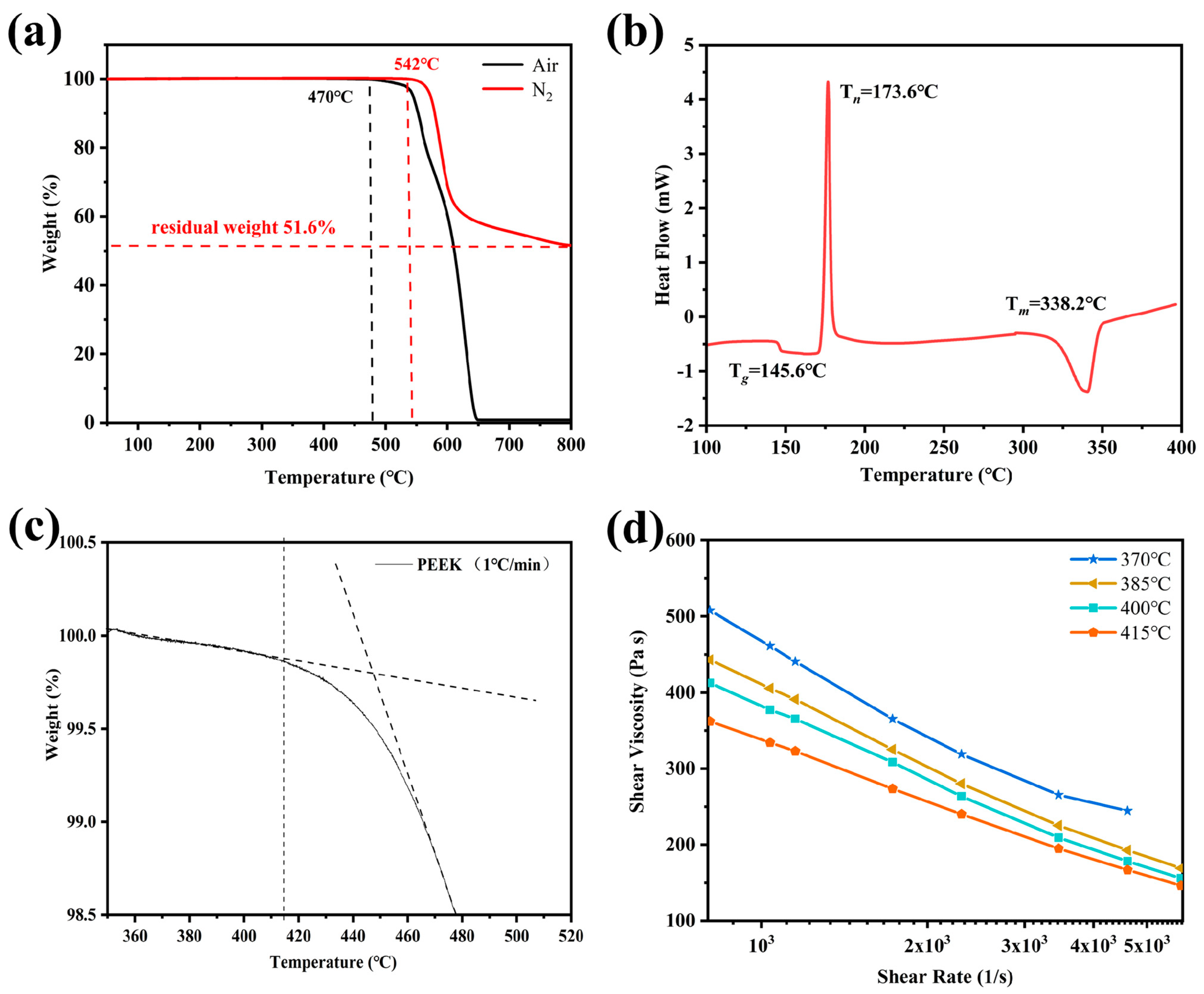

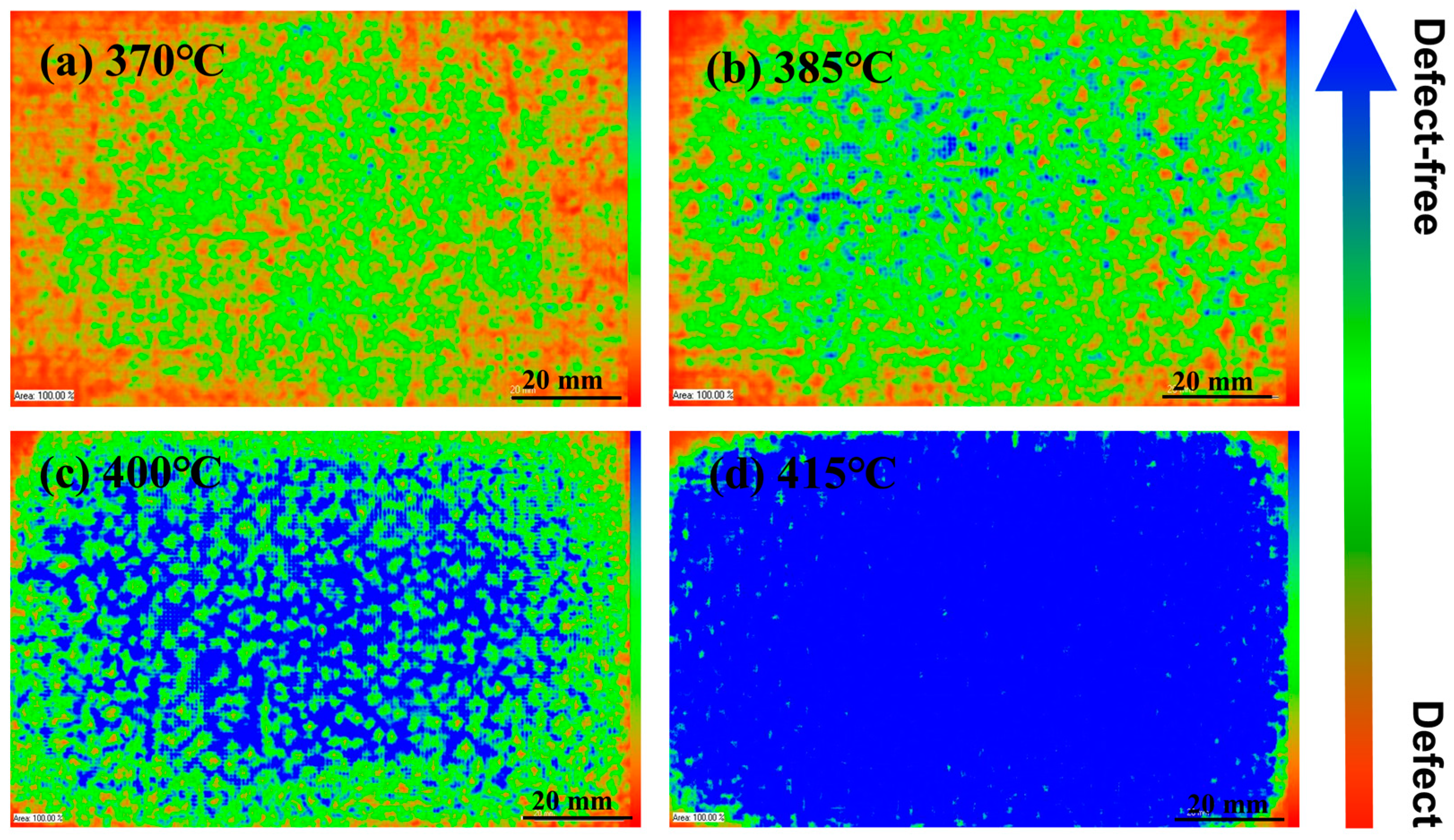

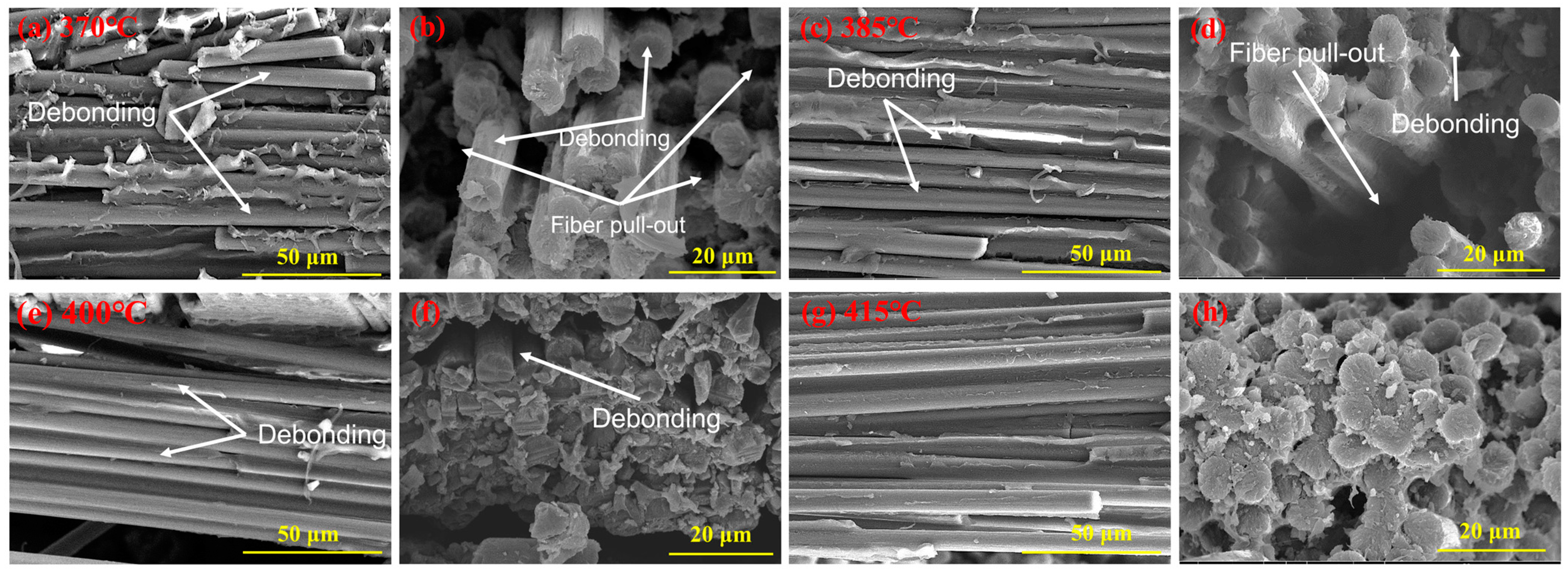





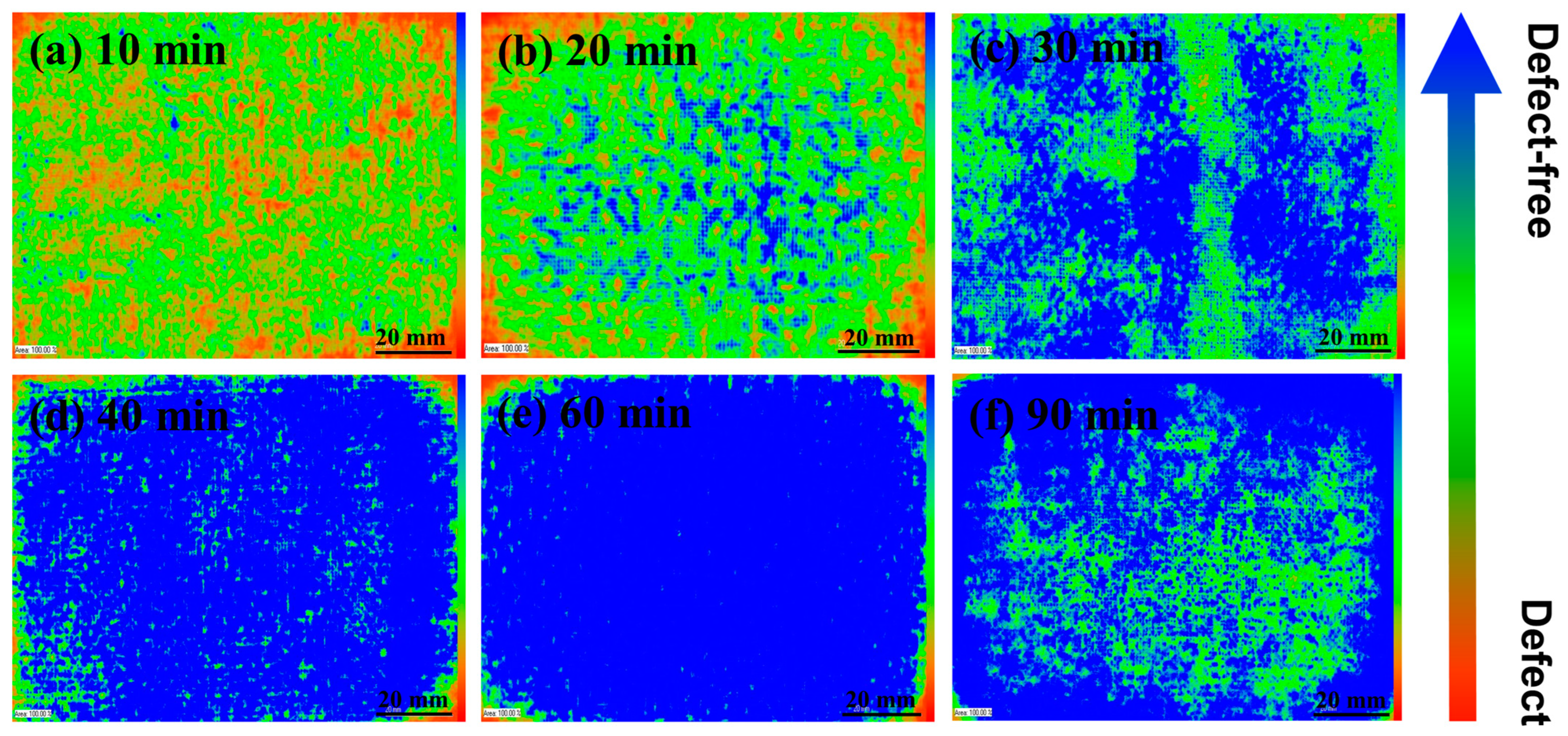

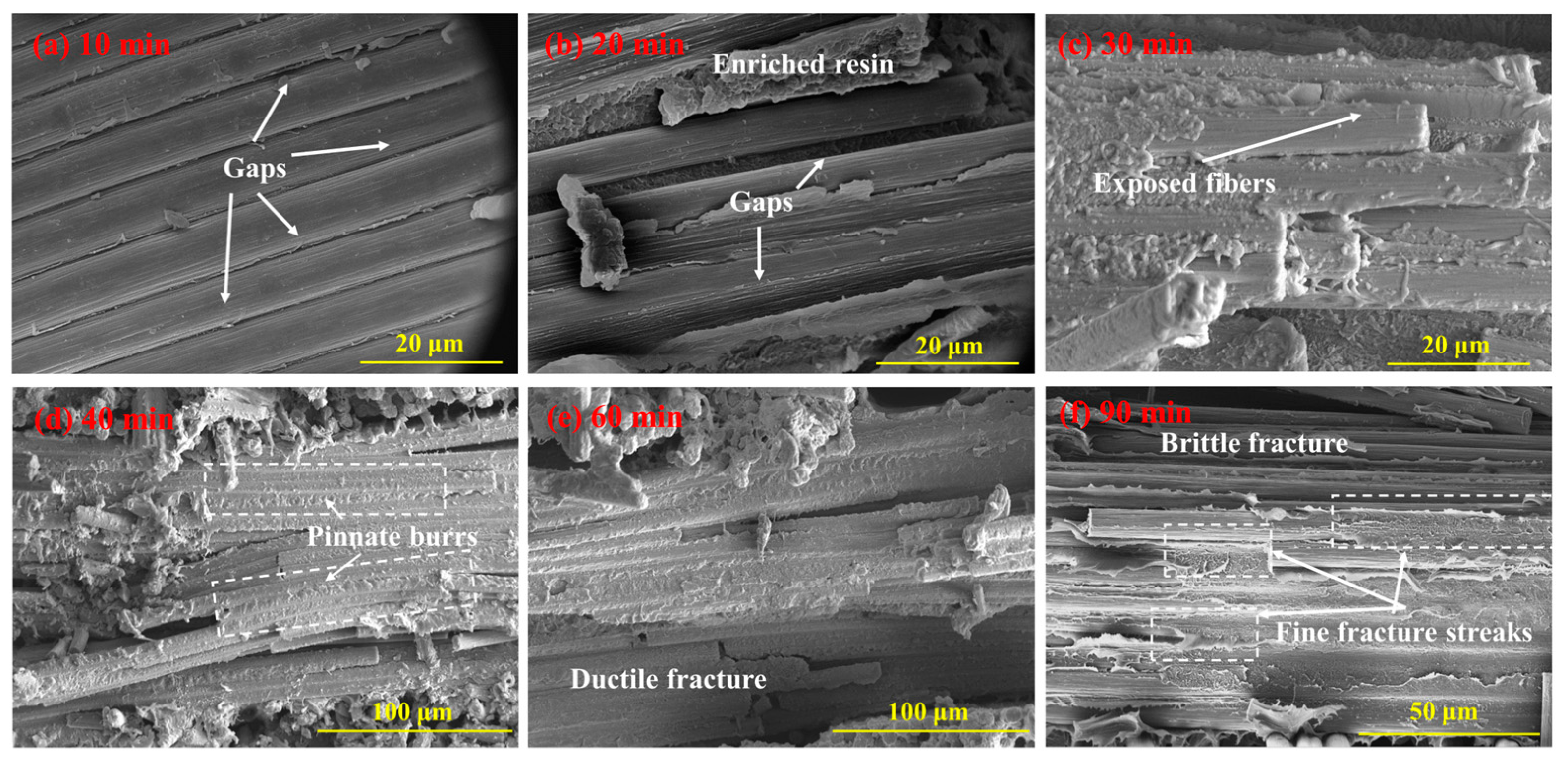
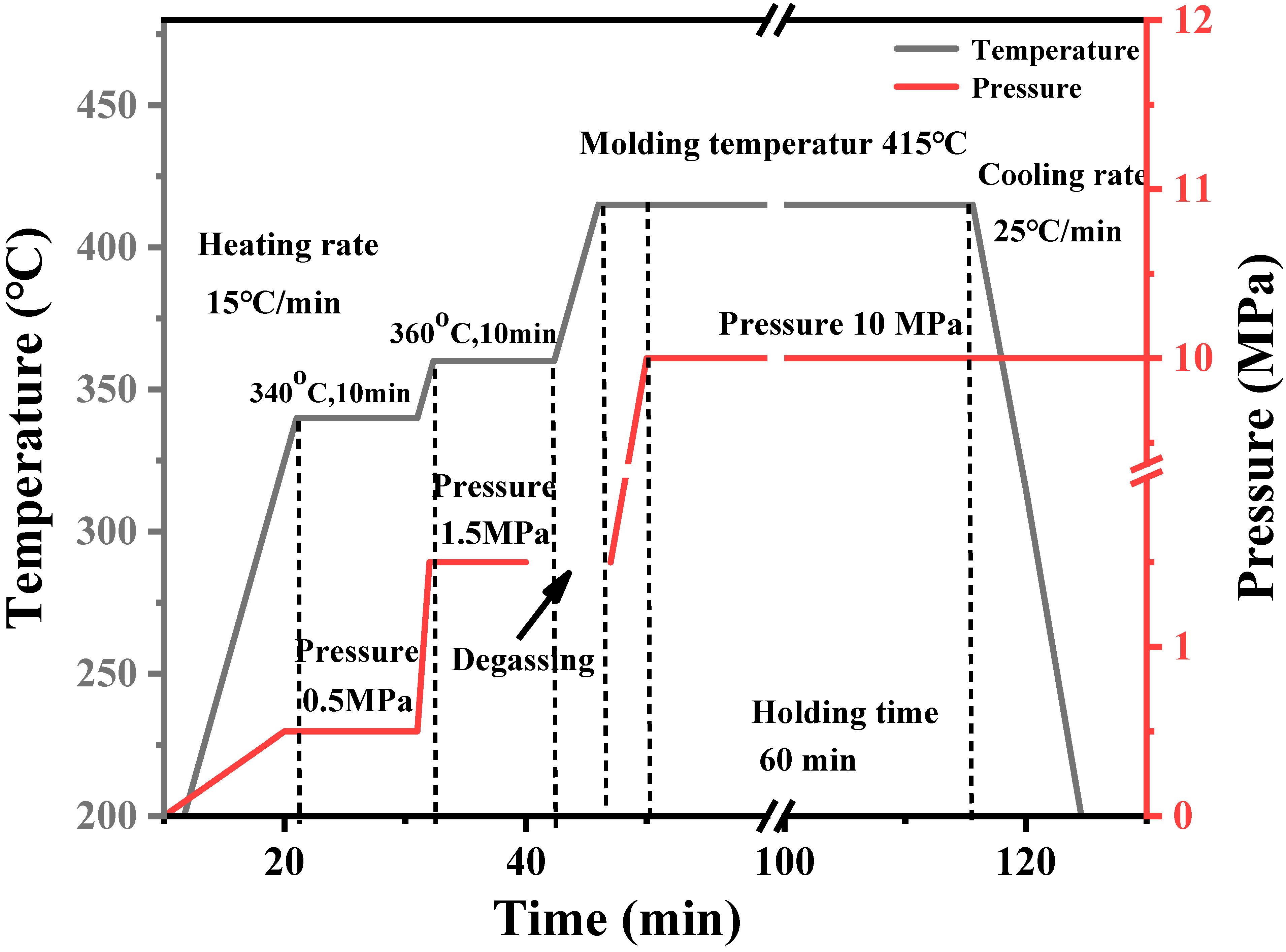


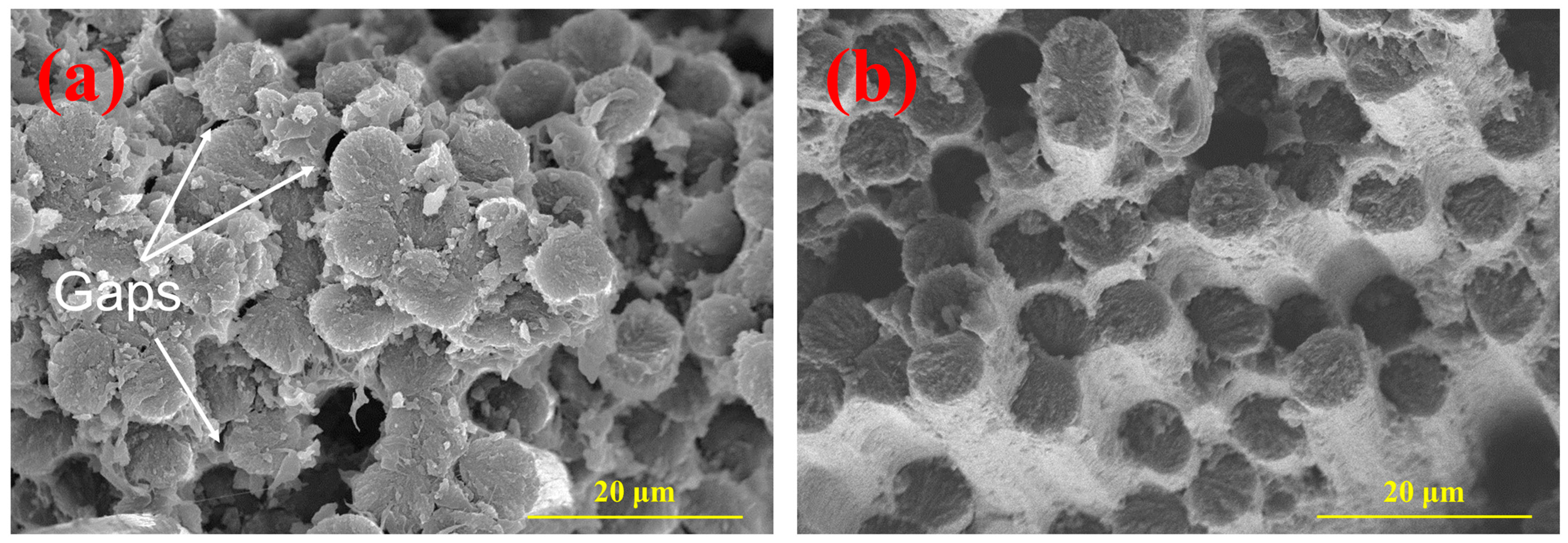
| Molding Temperature (°C) | ILSS (MPa) | Flexural Strength (MPa) | Flexural Modulus (GPa) | Tensile Strength (MPa) | Tensile Modulus (GPa) |
|---|---|---|---|---|---|
| 370 | 40.5 | 455.9 | 64.6 | 652.2 | 57.2 |
| 385 | 47.3 | 509.9 | 65.7 | 738.8 | 58.4 |
| 400 | 51.2 | 601.8 | 65.9 | 752.7 | 59.4 |
| 415 | 57.8 | 681.5 | 66.3 | 781.8 | 58.3 |
| Molding Press (Mpa) | ILSS (MPa) | Flexural Strength (MPa) | Flexural Modulus (GPa) | Tensile Strength (MPa) | Tensile Modulus (GPa) |
|---|---|---|---|---|---|
| 1 | 42.4 | 478.7 | 63 | 662.1 | 53.9 |
| 2 | 50.9 | 561.2 | 64.5 | 673.6 | 57.6 |
| 4 | 52.9 | 601.8 | 65.4 | 716.2 | 57.7 |
| 8 | 56 | 641.6 | 66.1 | 753.9 | 58.2 |
| 10 | 57.8 | 681.5 | 66.3 | 781.8 | 58.3 |
| Molding Time (min) | ILSS (MPa) | Flexural Strength (MPa) | Flexural Modulus (GPa) | Tensile Strength (MPa) | Tensile Modulus (GPa) |
|---|---|---|---|---|---|
| 10 | 41.1 | 444.6 | 64.2 | 661.5 | 55.8 |
| 20 | 42.8 | 454.5 | 64.5 | 673.5 | 56.4 |
| 30 | 54.5 | 565.2 | 64.6 | 759.7 | 57.4 |
| 40 | 55.7 | 634.4 | 64.6 | 762.7 | 57.8 |
| 60 | 57.8 | 681.5 | 66.3 | 781.8 | 58.3 |
| 90 | 55.5 | 626.4 | 65.1 | 745.8 | 57.5 |
| ILSS (MPa) | Flexural Strength (MPa) | Flexural Modulus (GPa) | Tensile Strength (MPa) | Tensile Modulus (GPa) | |
|---|---|---|---|---|---|
| Without pre-pressure | 57.8 | 681.5 | 53.6 | 781.8 | 58.3 |
| With pre-pressure | 62.5 | 754.4 | 67.1 | 796.1 | 61.4 |
Disclaimer/Publisher’s Note: The statements, opinions and data contained in all publications are solely those of the individual author(s) and contributor(s) and not of MDPI and/or the editor(s). MDPI and/or the editor(s) disclaim responsibility for any injury to people or property resulting from any ideas, methods, instructions or products referred to in the content. |
© 2024 by the authors. Licensee MDPI, Basel, Switzerland. This article is an open access article distributed under the terms and conditions of the Creative Commons Attribution (CC BY) license (https://creativecommons.org/licenses/by/4.0/).
Share and Cite
Wang, Y.; Yang, Y.; Zhang, H.; Ding, S.; Yang, T.; Pang, J.; Zhang, H.; Zhang, J.; Zhang, Y.; Jiang, Z. Study on the Preparation and Process Parameter-Mechanical Property Relationships of Carbon Fiber Fabric Reinforced Poly(Ether Ether Ketone) Thermoplastic Composites. Polymers 2024, 16, 897. https://doi.org/10.3390/polym16070897
Wang Y, Yang Y, Zhang H, Ding S, Yang T, Pang J, Zhang H, Zhang J, Zhang Y, Jiang Z. Study on the Preparation and Process Parameter-Mechanical Property Relationships of Carbon Fiber Fabric Reinforced Poly(Ether Ether Ketone) Thermoplastic Composites. Polymers. 2024; 16(7):897. https://doi.org/10.3390/polym16070897
Chicago/Turabian StyleWang, Yan, Yanchao Yang, Hongbo Zhang, Siwen Ding, Ting Yang, Jinhui Pang, Haibo Zhang, Jinling Zhang, Yunhe Zhang, and Zhenhua Jiang. 2024. "Study on the Preparation and Process Parameter-Mechanical Property Relationships of Carbon Fiber Fabric Reinforced Poly(Ether Ether Ketone) Thermoplastic Composites" Polymers 16, no. 7: 897. https://doi.org/10.3390/polym16070897
APA StyleWang, Y., Yang, Y., Zhang, H., Ding, S., Yang, T., Pang, J., Zhang, H., Zhang, J., Zhang, Y., & Jiang, Z. (2024). Study on the Preparation and Process Parameter-Mechanical Property Relationships of Carbon Fiber Fabric Reinforced Poly(Ether Ether Ketone) Thermoplastic Composites. Polymers, 16(7), 897. https://doi.org/10.3390/polym16070897






